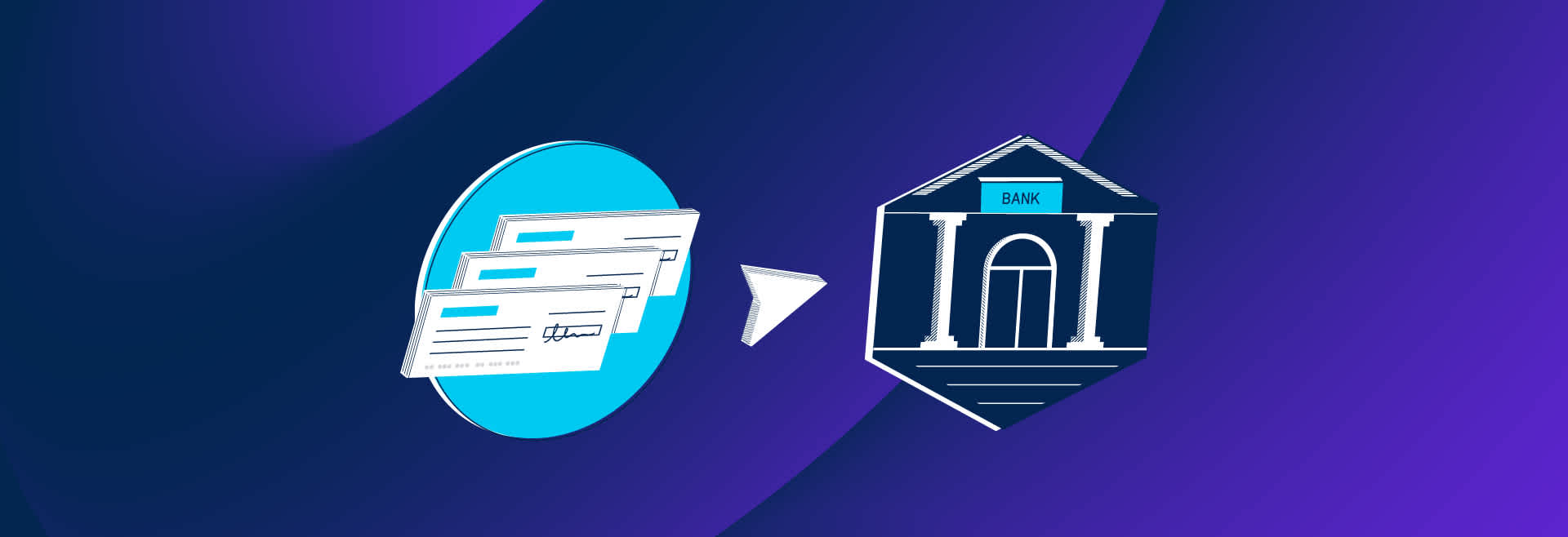Checks and balances: The shift from checks to bank debit

Last editedDec 20205 min read
Checks were once the obvious way for businesses to pay and get paid. In a paper world, they were convenient, which is why even though the manual processing of checks by the banks took two days, by the early 1950s every single American was writing around one check a week. The history of checks also shows us that everyone likes faster payment processing: computerized processing fueled a continued boom in check use which only peaked in 1995 (with 49.5 billion checks written).
1995, of course, is when online payments began to become mainstream, but up until the pandemic, the check was not done.
The US has been stubbornly resistant to moving away from checks, unlike much of the rest of the world. The Wall Street Journal quotes an expert from the Association for Financial Professionals (AFP), saying “Businesses know the check system works. It's been around for a long time, and they feel very comfortable with it.” The AFP’s 2019 Electronic Payments Survey found that checks (42%) were still the most popular payment method for business-to-business (B2B) transactions.
Why? First, there is a cost to businesses in refactoring their systems. The Atlanta Fed’s Catherine Thaliath writes, “Companies are deterred by the complex restructuring involved with digitizing their accounts payable (AP) systems.” In a world where businesses are already under financial stress from the complexities of COVID and a constant stream of exciting but demanding technological advancements, back office refactoring often takes a back seat. Even though, as Thaliath continues, “there are benefits—it's less labor-intensive and, even though costs to convert to digital could be substantial, the platforms are faster.”
Second, we often make technology decisions according to which customers shout loudest – and it turns out that customers don’t shout much about payments. For example, whatever you may have thought about the next generation of consumers, a Qualtrics survey showed that 42% of Millennials still use checks and 87% have written a check in the past three months. Financial services marketers Harland Clarke write, “If the vendor a millennial needs to pay doesn’t use mobile apps for payments, it’s easier to write a check than figure out and download a technology you can both agree upon.”
This is true for B2B too: customers will go digital if they can, but they are looking for their suppliers to take the lead. In other words, “build it and they will come”.
The burning platform – a compelling case for digital
COVID might just turn out to have been the burning platform for change – what PaymentsSource has called “the biggest threat to the check’s dominance than anything before.”
Jane Larimer, President and CEO of Nacha, the governing body for ACH (bank debit) payments, summarizes the new challenges for checks as presented by the pandemic crisis: “Paying with paper is a big pain point—especially under the constraints of social distancing. As an example, having no one in the office to sign checks is a problem… Similarly, a business’ accounts receivable department probably wasn’t in the office to handle checks arriving by mail.”
And the pandemic has played havoc with payment intake. Forrester conducted research in November 2020 for GoCardless, speaking to 297 US payments decision makers. They reported, “Over half of US respondents report that time to receive payments has increased in the last 12 months, with almost 80% saying it takes them more than 20 days.” Worse still, a recent survey from PYMNTS and American Express found that the pandemic has stretched the average Days Sales Outstanding metric to beyond 40 days (DSO – the number of days it takes to collect a payment, and of course therefore a direct influence on cash flow). The Forrester report adds that DSO is becoming a mission-critical priority: “Additionally, many US firms face significant challenges relating to DSO, such as navigating banking procedures both inside and outside of the US and customers’ bank transfers taking too long to process. Unsurprisingly, reducing DSO is a high or critical priority in the next year for over 80% of US payment decision-makers.”
Without doubt, some customers have just taken advantage of the pandemic to stall, but PYMNTS also point out that “entrenched manual processes have caused companies to struggle with collections”. Checks are a key culprit:
They are slow and manual (Forrester research commissioned by GoCardless shows that processing paper checks is one of the three top causes of poor cash flow)
As Larimer points out, they require a physical presence in the office
Unlike bank debit, checks and wire transfers rely on the payer to initiate the payment
Checks are even slower internationally - if they are accepted at all (much of the rest of the world has moved away from them completely)
And checks have always been a mine of B2B fraud (The Atlanta Fed’s 2018 Check Sample Survey found that B2B bill payments accounted for 56% of the value of fraudulent checks but only 14% of throughput)
PaymentsSource again: “In the wake of the pandemic, businesses have seen their operations turned upside down overnight. The reconfiguration of AR and AP teams across the world has made it critical to be able to send and receive payments from the comfort of home. The manual and expensive efforts involved in processing paper checks don’t easily fit into this new normal, especially when optimizing resources and bandwidth is more important than ever.” Our Forrester research found that many of the most challenging payment processes were particularly associated with checks; including matching payments to open invoices (cited by 65% of businesses as among the most labour intensive areas of payments management) and chasing unpaid invoices (59%).
These challenges have led to some big decisions. The PYMNTS/Amex survey reports that 64% of companies surveyed are shifting away from physical invoices, and a full 60% of companies are preparing to automate their AR systems. The case for paper anywhere in the billing and payments cycle is becoming increasingly weak.
It’s time to cut cost and effort
Digital payments support digital processes more broadly across the operation. Smart businesses are therefore following the lead of pioneering all-digital SaaS companies and deriving significant benefit by moving away from checks to digital payment methods like bank debit:
Their cash flow is improved. PYMNTS reports, “Companies that are marked by manual AR operations have DSOs that stretch out 30 percent longer than companies that have at least a medium to high level of automation of those same AR processes. And when it comes to chasing down late payments, it takes manually-oriented companies 67 percent longer to follow up on overdue payments.”
AR teams buy back the time, effort and money previously squandered on repetitive and low-grade manual tasks. That time can be put to more productive - and enjoyable - purposes. In the words of Samuel Wilson, Chief Customer Officer and Managing Director at 8x8, the cloud VoIP services provider, “The GoCardless platform not only means that we can provide a great experience to our customers; it has also enabled us to consolidate our paper-based processes and legacy systems into a single payments platform.”
Thanks to cloud-based administration systems (including GoCardless), AR employees can work anywhere – ideal as we learn to handle the post-COVID business landscape.
Bank debits are initiated by the payee, completely removing a layer of complexity and cash flow unpredictability from the payment process. Furthermore, with the flexibility to support recurring payments, they are ideal for the SaaS/subscription business models which began in tech but which are becoming prevalent across B2B services.
And bank debits are a choice which customers want. GoCardless’ Global Payment Preferences report shows that at least one third of consumers are likely to choose Bank Debit/Direct Debit to pay for online subscriptions
Processing is simple and economical too, bringing a digital payment ecosystem within the grasp of businesses large and small. Analysts IDC point out, “Essentially bank debit saves cost. Compared with card payments, which charge around 1.5%–5% per transaction, bank debit transaction costs are much lower, at around 1%.” In the words of one GoCardless customer, “Payments are scheduled & pulled every month like clockwork. The fees are minimal for ACH processing, especially when compared to credit card processors.” Conversely, Bank of America estimates the cost of a business check to be usually between $4 and $20!
A digital finance function has always made sense, but there have also always been other priorities for businesses to consider. A blend of the challenges of COVID and B2B customer demand for new commercial models are allowing payments processes and AR systems to rise up the operational agenda. The Forrester report continues, “With COVID-19 impacting the handling of manual payments like checks, the importance of expediting the payments modernization journey from paper to digital — and from manual to automated transactions — is becoming increasingly urgent. Most (70%) B2B decision-makers are embracing bank debit (known as ACH debit in the US) more than check payment. With technology advancements in digital payments, checks are becoming burdensome for US firms to use, especially as more efficient payment models exist.”
As manual processing looks increasingly arcane, it’s time for US businesses to follow the rest of the world in the inevitable march away from checks; and into supporting the digital workflows that give customers a better experience – and dramatically cut your costs, too.

